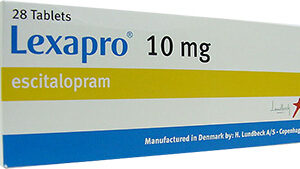Anafranil, also known by its generic name clomipramine, is a tricyclic antidepressant that is primarily used to treat symptoms of obsessive-compulsive disorder (OCD). It works by affecting the balance of certain chemicals in the brain, helping to alleviate anxiety and control the intrusive thoughts and repetitive behaviors associated with OCD.
This medication is available in tablet form and is typically taken orally. It is classified as a prescription-only medication and should only be used under the guidance and supervision of a healthcare professional.
It is important to note that Anafranil may take several weeks to show its full therapeutic effects, so it is essential to follow the prescribed dosage and continue taking the medication as directed by your healthcare provider.
What to Avoid When Taking Anafranil
Before starting treatment with Anafranil, it is crucial to be aware of certain contraindications that may affect its safe use. Individuals with the following conditions should avoid taking Anafranil:
- Hypersensitivity to clomipramine or any of its components
- Recent myocardial infarction (heart attack)
- Narrow-angle glaucoma
- Urinary retention
- Seizure disorders
- Severe hepatic (liver) impairment
Additionally, it is important to exercise caution when taking Anafranil if you have a history of cardiovascular disease, diabetes, schizophrenia, or other mental health disorders. Consult your healthcare provider to determine if Anafranil is safe for you.
Adverse Reactions
As with any medication, Anafranil may cause certain side effects. It is important to monitor your body’s response to the drug and promptly inform your healthcare provider if any adverse reactions occur. Common side effects may include:
- Drowsiness
- Dizziness
- Blurred vision
- Constipation
- Dry mouth
- Nausea
- Weight gain
Less common, but potentially more serious side effects may include:
- Irregular heartbeat
- Fainting
- Muscle stiffness or twitching
- Uncontrolled movements
- Mental or mood changes (e.g., confusion, agitation, hallucinations)
If you experience any severe or persistent side effects, it is crucial to seek immediate medical attention.
How to Take It
When taking Anafranil, it is crucial to follow the prescribed dosage and administration instructions provided by your healthcare provider. It is typically recommended to take the medication with food or milk in order to minimize stomach upset. Avoid grapefruit or grapefruit juice while taking Anafranil, as it may increase the medication’s concentration in the blood, leading to potential side effects.
If you accidentally miss a dose, take it as soon as you remember. However, if it is close to the time for your next scheduled dose, skip the missed dose and resume your regular dosing schedule. Do not double the doses to catch up.
Anafranil should not be stopped suddenly without consulting your healthcare provider, as abrupt discontinuation may lead to withdrawal symptoms. Your doctor may gradually reduce your dosage before completely stopping the medication.
In the event of an overdose, seek emergency medical assistance immediately. Overdose symptoms may include agitation, confusion, hallucinations, seizures, severe drowsiness, and a fast or irregular heartbeat.
Interactions Guide
There are several drug interactions that may occur when taking Anafranil. It is important to inform your healthcare provider about all medications and supplements you are currently taking to ensure safe coadministration. Some notable drug interactions include:
| Drug Class | Interacting Medications |
|---|---|
| Monoamine oxidase inhibitors (MAOIs) | Linezolid, methylene blue, moclobemide, phenelzine, rasagiline, selegiline, isocarboxazid, tranylcypromine |
| Selective serotonin reuptake inhibitors (SSRIs) | Fluoxetine, sertraline, paroxetine, fluvoxamine, citalopram, escitalopram |
| Antihistamines | Diphenhydramine, cetirizine, loratadine, fexofenadine |
| Anticholinergic drugs | Amitriptyline, atropine, benztropine, scopolamine |
This is not an exhaustive list, and there may be other drug interactions possible. Always consult your healthcare provider or pharmacist for personalized advice based on your specific medications and medical history.
Q&A
-
Q: What should I do if I forget to take a dose of Anafranil?
A: If you accidentally miss a dose, take it as soon as you remember. However, if it is close to the time for your next scheduled dose, skip the missed dose and resume your regular dosing schedule. Do not double the doses to catch up.
-
Q: Can I drink alcohol while taking Anafranil?
A: It is generally recommended to avoid alcohol while taking Anafranil, as alcohol may increase the sedative effects of the medication and potentially worsen side effects such as drowsiness and dizziness.
-
Q: How long does it take for Anafranil to start working?
A: Anafranil may take several weeks before you notice its full therapeutic effects. It is important to continue taking the medication as directed by your healthcare provider, even if you do not immediately feel its effects.
-
Q: Can Anafranil be used during pregnancy?
A: The use of Anafranil during pregnancy should be carefully considered and discussed with your healthcare provider. It may only be used if the potential benefits outweigh the potential risks. Inform your doctor if you are pregnant or planning to become pregnant while taking Anafranil.
-
Q: Can Anafranil be safely used in children?
A: Anafranil may be prescribed to children under the supervision of a healthcare professional. However, dosage and usage guidelines may differ for pediatric patients. Consult a pediatrician for appropriate guidance.






Reviews
There are no reviews yet.